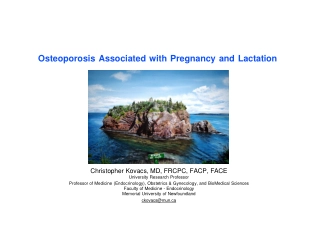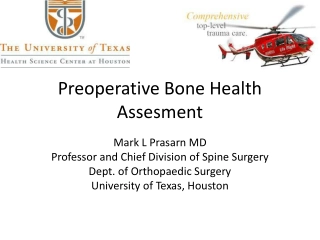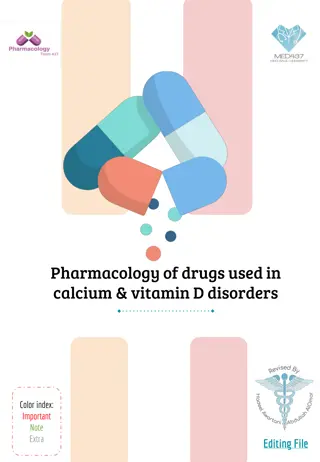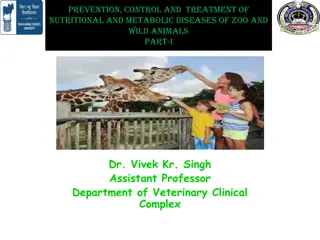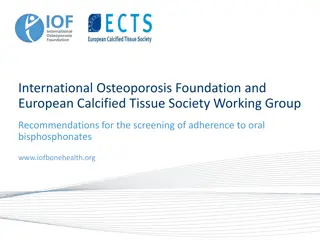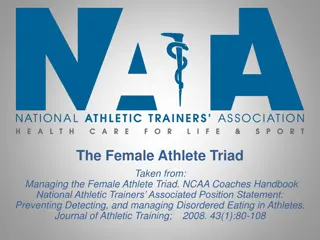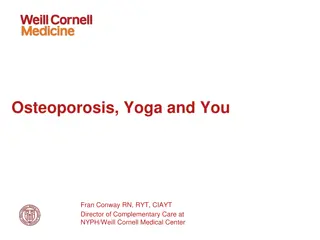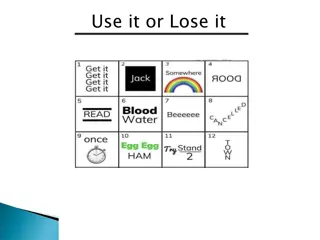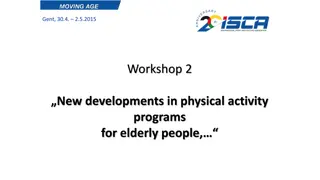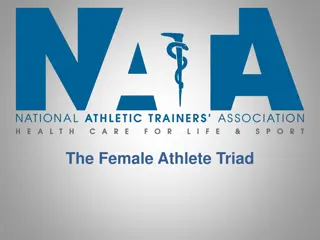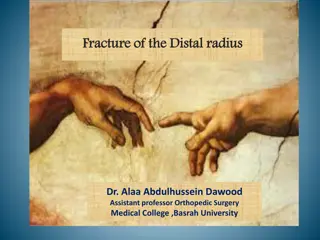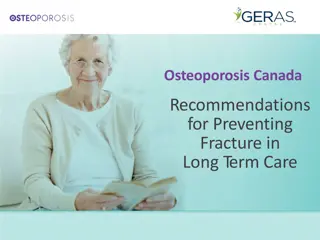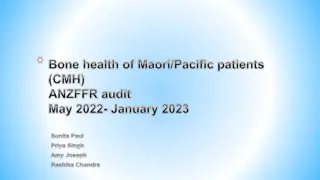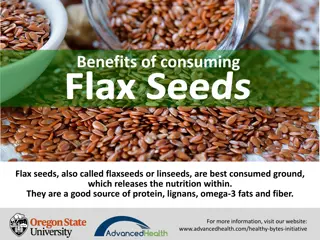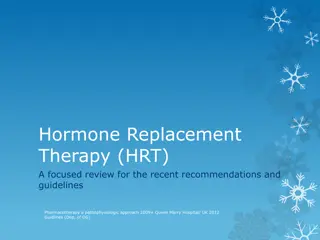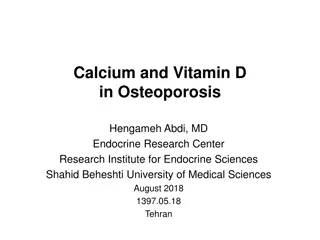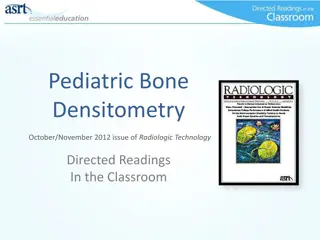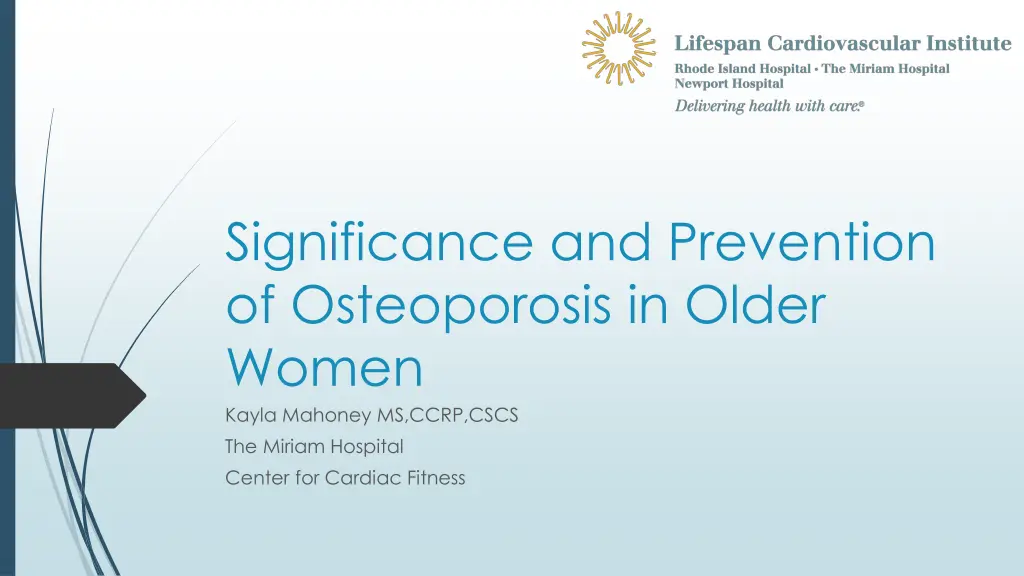
Osteoporosis in Older Women: Significance & Prevention
Learn about the significance of osteoporosis in older women, including risk factors, screening methods, treatment options, and prevention strategies. Understand the impact of bone density loss, fracture risks, and the importance of early diagnosis. Explore the prevalence of osteopenia and osteoporosis, and discover how to effectively address and manage these conditions to maintain bone health and reduce the risk of fractures as you age.
Download Presentation

Please find below an Image/Link to download the presentation.
The content on the website is provided AS IS for your information and personal use only. It may not be sold, licensed, or shared on other websites without obtaining consent from the author. If you encounter any issues during the download, it is possible that the publisher has removed the file from their server.
You are allowed to download the files provided on this website for personal or commercial use, subject to the condition that they are used lawfully. All files are the property of their respective owners.
The content on the website is provided AS IS for your information and personal use only. It may not be sold, licensed, or shared on other websites without obtaining consent from the author.
E N D
Presentation Transcript
Significance and Prevention of Osteoporosis in Older Women Kayla Mahoney MS,CCRP,CSCS The Miriam Hospital Center for Cardiac Fitness
Objectives Define Identify Risk Factors Screening Treatment Prevention
Osteoporosis = loss of bone mass Bone density peaks at age 30 and declines with age Significant loss a few years after menopause Drop in estrogen Less osteoclast inhibition Risk of bone fractures increase Hip is most common secondary to falls
Risk Factors Non-Modifiable White/Asian Female Modifiable Heavy smoking >50 years old Heavy Drinking Menopause prior to age 45 Osteopenia Family History (first degree relative) History of eating disorders Calcium and Vit D deficiency Late Menstruation/Ammenorrhea Sun exposure Small/Thin Frame (<125 lbs) Sedentary Lifestyle History of previous fracture Inflammatory Diseases Celiac, IBD, Lupus etc. Corticosteroid Medications
Diagnosis/Screening Dual Energy X-Ray Absorptiometry (DEXA) Scan Gold Standard, non-invasive, little radiation exposure All women over 65, or younger with RF s T scores compare a patient s bone density to that of a healthy 30-year-old of the same gender. The more negative the number, the less dense the bones. Osteopenia is diagnosed if the T score is between -1 and -2.5. Osteoporosis is diagnosed if the score is less than -2.5. Severe established osteoporosis (SEO) is diagnosed if the T score is less than -2.5 and someone has had a fracture.
Prevalence 18 million Americans have osteopenia, and 10 million have osteoporosis Fifty percent of women and 20% of men have it, and by age 75, 70% of men and women will have it 1 in 5 women over age 50 have osteoporosis by age 65 Half of all women over 50 will have a hip, vertebral, or wrist fracture at some point in their lives Don t worry, there is something we can do about this but what is it? Looker AC, Melton LJ, Harris TB, et al. Prevalence and trends in low femur bone density among older US adults: NHANES 2005-6 compared with NHANES III. J Bone Miner Res 2010;25(1):64-71.
Prevention Eat a balanced diet rich in Calcium (1200mg) and Vitamin D3 (cholecalciferol 1000-2000IU) Supplement if necessary (Speak to your MD) DASH and Meditteranean Diets have been shown to have bone sparing effects Limit Alcohol, Soda, and Caffeine Don t Smoke or use other tobacco products Menopause 45 years = estrogen replacement therapy (Speak to MD) Exercise regularly Weight bearing (walking, dancing, Tai Chi, etc) Resistance Training 8-10 Large Muscle Mass Exercises 2-3 sets 10-15 reps Kotsirilos V, Vitetta L, Sali A, et al. Osteoporosis. In A Guide to Evidence-Based Integrative and Complementary Medicine. Sydney, Australia:Churchill Livingstone, 2011.
Fall Prevention Remain active (Strength/Core Training and Balance Training) Annual Eye Exams Medications Wear proper/supportive footwear Secure rugs that slip and avoid raised rugs Arrange furniture to clear paths Use assistive devices properly Install handrails at entry/stairs Install bench/grab bars in shower/toilet Use non-slip mat in shower and on bathroom floor Install Night Lights
Local Programs BENEFTS: Bone Strength Longevity Brain Cell Development Antidepressant Cardiovascular Health Lower Cholesterol Prevention and Control of Diabetes Reduce blood Pressure Reduce Risk of Stroke Weight Control Muscle Strength Better Sleep https://bonebuildersri.com/ (401) 949-1333 Inquire with your local Senior Centers for offerings YMCA: group fitness for seniors

